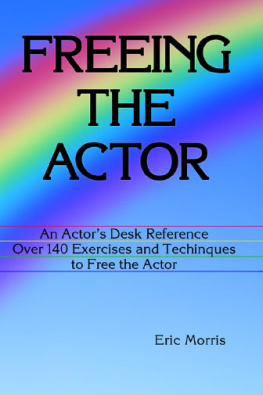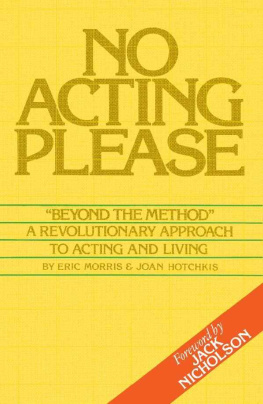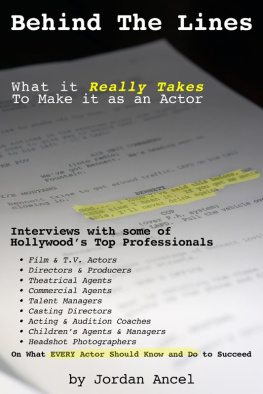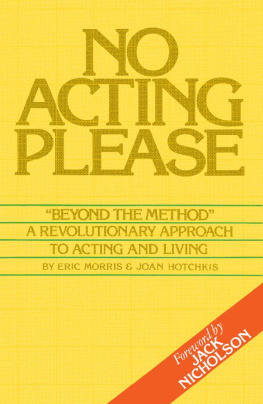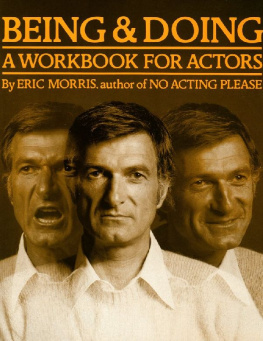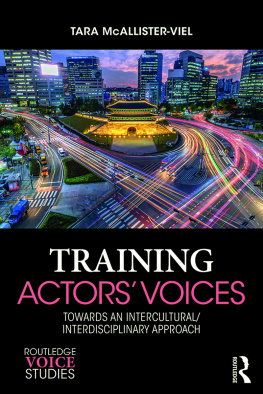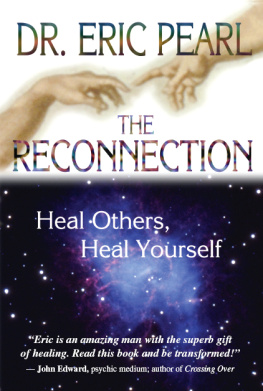
ABOUT THE AUTHOR
Erics work has given me the foundation on which Ive built my work for the past 25 years as a film and TV director.
David Anspaugh, director
What I learned from Eric Morris informs anything worthy Ive ever done.
Hampton Fancher, writer, director
Since the 1970s Eric has been my colleague, mentor, superb acting teacher and a cherished friend.
Joan Hotchkis, actor, writer
If you want to be still and full, Eric teaches the stuff.
Jack Nicholson, actor
Eric freed my soul of limitations and taught me how to express my artistic talents. He is one of the greatest teachers of life in the world.
Scott Steindorff, producer
Eric Morris has utilized our work masterfullyintegrating profound psychological insights into his teachings and providing a unique approach to the craft of acting.
Hal Stone, Ph.D. & Sidra Stone, Ph.D., clinical psychologists,
authors, and creators of Voice Dialogue
Eric Morris helps actors develop the tools and fundamentals that they take with them throughout their careers. I know. I am one of them. Thanks, Eric.
Scott Wilson, actor
FREEING
THE ACTOR
An Actors Desk Reference
with over 140 Exercises and Techniques
to Eliminate Instrumental Obstacles
ALSO BY ERIC MORRIS
No Acting Please (with Joan Hotchkis)
Being & Doing
Irreverent Acting
Acting from the Ultimate Consciousness
Acting, Imaging, and the Unconscious
The Diary of a Professional Experiencer
AUDIO TAPES
The Craft of Acting
The MegApproaches
Imaging for Acting
THE ERIC MORRIS ACTORS WORKSHOP IS LOCATED AT:
5657 Wilshire Blvd. Los Angeles, CA 90036 (323)466-9250
Internet Web site
www.ericmorris.com
FREEING
THE ACTOR
ERIC MORRIS
ERMOR ENTERPRISES
Edited by Carin Galsett
Published by
Ermor Enterprises
8004 Fareholm Drive
Los Angeles, CA 90046
Copyright 2011 by Eric Morris
All rights reserved. This book, or parts thereof,
may not be reproduced in any form without permission.
ISBN 978-0-9629709-6-2
This book is dedicated to the memory of
Paul Whitehouse
a wonderful friend, who always supported my writing. He encouraged me to publish my first book, No Acting Please , for which he also did the art work. Without him none of my other books would have even been written. I have never known a kinder or better human being. I will continue to miss him.
TABLE OF CONTENTS
OBJECTIFYING AND ALLEVIATING
THE INSECURITIES
INTRODUCTION
This book is for actors, directors and teachers. It is exclusively focused on the actors instrumental obstacles and problems. Most of the issues that block actors from achieving a relaxed being state will be listed and described in the following pages, as well as the exercises designed to eliminate those problems, which keep actors from being free to act.
Historically, in the training of actors, the instrument has been neglected and overlooked, and, as a result, actors with fewer instrumental blocks have been able to function fairly well, while the others, who may have been even more gifted, were relegated to suffering the obstacles that strangled their talent. From the beginning of my journey as a teacher of acting I struggled against enormous criticism and resistance to the work I was doing to address those obstacles and antidote them. In spite of the hurdles I had to climb over, I was able to create hundreds of instrumental exercises that really work. The results have been life changing for many of the actors who remained on the journey long enough to eliminate their problems and become free to act .
Doctors have a Desk Reference that they can consult in order to get answers about certain drugs and treatments. In the same way, this book is a desk reference for actors, in which they can find help to address and eliminate the blocks that keep them from functioning. It will also be very helpful to directors who are dealing with actors who have problems in the creative process. I hope that acting teachers who read this book will use many of the exercises herein to help free their students from the blocks and obstacles that keep them from being instrumentally free to act.
THE INSTRUMENT
The instrument is youyour mind, body, voice and emotions. If you were a musician, your instrument would be your violin, harp, piano, saxophone, etc.; but as an actor you have yourself, and that is the instrument you play. The instrument is the vehicle that expresses the talent of the artist, and if it is damaged and cannot function to the optimum of its capabilities, then the artists talent is seriously inhibited. For example, if the violin a musician is playing is missing a string and the other strings are not taut enough to produce the right sounds, no matter how talented the violinist is, he will be unable to express that talent, as will a pianist who has a piano that is completely out of tune. The same holds true for the actor: Whatever the obstacle is, it will stop him from accessing and expressing his unique talent.
There is no difference between living and acting. Obstacles that plague a person in life become even bigger when he or she tries to act. We grow up in a society with rules and taboos, as well as judgments and criticisms, and when we reach adulthood, we suffer from a multitude of inhibitions, fears, and blocks of all kinds. The unfortunate reality is that most actors pursue their craft and career badly damaged and unable to access the depth of their real talent. In the thirty-two hundred years since the proverbial Thespis stepped out of the Greek chorus and became the first actor, almost nothing has been addressed in the training of actors to liberate their instrument so that they could call upon their talent. Teachers and coaches have sadly neglected the instrumental liberation of the people they train. Lee Strasberg, for whom I have a great deal of respect for the contribution he made to the training of actors, neglected to get deeply involved on a personal level with his actors instrument. He felt that it would be crossing the line between acting and psychotherapy and refused to even listen to actors describe personal experiences, which he felt were meant for the psychotherapist. So in reality many of the actors with fewer problems functioned better than those with more and greater obstacles. The sad reality is that most likely those with the larger issues were often infinitely more talented than the ones with fewer obstacles.
I have written six other books to date, and many of my exercises and techniques are addressed in those books; so why write another one dealing with issues already discussed and investigated? Well, there are several reasons. One very important one is that I have grown in the many years since I wrote some of those texts; I have improved some of my techniques, which now go further and deeper in certain areas than they did originally, and I have invented new ones. Secondly, unlike the others, this book focuses entirely on the instrument, describing in great detail the problems and obstacles that actors experience. They will be listed in a very specific order, complete with the antidotal exercises to address and eliminate them. In the introduction, I mentioned that this book is much like a Physicians Desk Reference . It lists almost all of the problems that a person can have instrumentally. Under each category there are several techniques and exercises that, in the same way as the entries in a PDR , address and alleviate the obstacles. The book can be used to identify whatever stands in the way of the actors ability to audition, rehearse, and perform. Most of us know how we feel under pressure or when we are obligated and tense about our ability to function successfully. When the issue is addressed, it can be dealt with, and the actor will be free to act.
Next page
